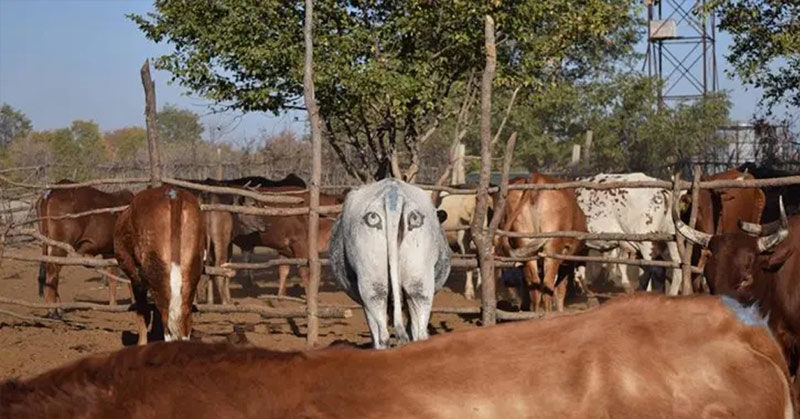In Botswana in Southern Africa, there are plenty of predators that threaten the livelihood of livestock producers. This requires them to come up with creative ways to protect their animals from these natural hunters. Their latest trick? Painting eyes on cattle – specifically, on their behinds.
Botswana Farmers are Painting Eyes on Cattle to Deter Predators
In Botswana, are one of the number one threats to a farmer’s cattle herd. These famous African animals include (1):
- Lions
- Hyenas
- Leopards
- Cheetahs
- African wild dogs
In the past, they’ve often had to resort to less humane ways of protecting them such as special fences or killing the attacker. (1)
Recently, they’ve discovered that painting eyes on cattle’s backsides is a remarkably effective way of deterring these predators – no fences or counterattacks necessary. (1)
Read: Ever Heard Of Albino Animals? Melanistic Animals Are The Opposite
Science-Backed Method
In Botswana, raising livestock takes up about 80% of the country’s agricultural earnings (3). This livestock, primarily cattle, graze in the same areas that their predators live. After years of farmers losing cattle – and money – to these animals, researchers decided it was time to come up with a new plan. (1)
Researchers at the University of New South Wales in Australia carefully studied how these predators hunt their prey. All of them rely on remaining undetected so that they can sneak up and attack unsuspecting cattle. If they could somehow convince the animals that they have been spotted, perhaps this would prevent them from trying. (1)
Of course, these predators, specifically the big cats, are strong, powerful animals. Despite this, their success rate while hunting is surprisingly low (4):
- 50% for cheetahs
- 38% for leopards
- 25% for lions
Attacking a potential dinner source requires a huge amount of energy, so in order to do-so, these cats must have a certain level of confidence that they will be successful. At the very least, they want to be sure that their prey doesn’t know that they are there. (1)
“Lions are ambush predators that rely on stalking, and therefore the element of surprise, so being seen by their prey can lead to them abandoning the hunt,” says joint UNSW Science and Taronga Western Plains Zoo researcher Dr Neil Jordan. “We tested whether we could hack into this response to reduce livestock losses, potentially protecting lions and livelihoods at the same time.” (2)
Read: Ethereal Portraits Highlight the Unique Beauty of a Girl With Albinism and Heterochromia
The Study
The researchers worked with local farmers of the region to test out their eyespot theory. Cattle from 14 different herds were painted that had a history of lion attacks. (5)
- ⅓ had eyes painted on their backsides
- ⅓ had a cross painted in the same location
- ⅓ were not painted
The results were surprisingly positive:
- No cows with eyes were killed
- Only four cows with crosses were killed
- 15 cows with no paint were killed
The most surprising, of course, were the crosses that also seemed to confuse predators enough to make them more hesitant to attack.
The study’s findings were published in Nature Communications Biology.
Mimicry
Eyespots are a form of mimicry using patterns that look like eyes to deter predators. It occurs naturally in many birds and butterflies but never has occurred in mammals. The research by the University of NSW demonstrates that mammals’ inherent response to eyes could be the key to ending the human-animal conflict in the livestock industry.
Botswana’s Cattle Industry’s Ongoing Struggle
In 2015, the cattle population of Botswana dropped to 1.7 million from 2.5 million in 2011. (1) This was caused by multiple factors, including (1):
- Droughts – animals are dying from lack of water and grass to graze
- Predators – the human-wildlife conflict in the country is a growing problem
Though solving the drought problem is another issue entirely, painting eyes on cattle will at least take care of part of the struggle. (1)
The researchers created practical guides that were translated both in English and Setswana to hopefully encourage more farmers to use this method as a cheaper, more humane way to control predators and protect their herds. (1)
Keep Reading: This Sea Slug Uses Photosynthesis and Looks Like Cluster of Leaves

